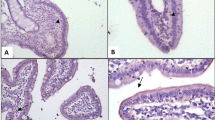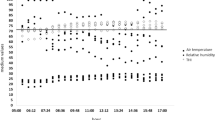Abstract
Capsaicin is a recognized alkaloid that can be used as a flavoring and palatability agent. These effects can increase feed intake in lactating sows during farrowing, especially under thermal stress conditions, and provide antioxidant and immunostimulant activities. The objective of this work was to find out the effects of a capsaicin-based product on the feed intake of sows, immunomodulation, and repercussions on litter performance and the control of piglet diarrhea conditions. A total of 132 pregnant sows and lactating sows and their respective litters were divided into 66 sows each and submitted to one of two possible treatments: a capsaicin-free diet (control group) or capsaicin per meal/day. Capsaicin was mixed with gestation and lactation diets in the proportion of 98.6 g of feed and 1.4 g of capsaicin/kg feed, with the dose administered “on top” of 100 g per treatment day on the first feeding. The sows were treated between 90 days of gestation and 21 days of lactation. Backfat thickness, feed intake during farrowing, colostrum production, IgG colostrum concentration, sow reproductive performance, piglet performance, and diarrhea were evaluated. Compared to the sows in the control group, those that received capsaicin had higher feed intake (+ 0.69 kg/day during lactation, P = 0.008), higher levels of IgG in colostrum (185.75 versus 153.80 mg/mL, P = 0.04), an 11.2% higher litter weight gain, with individual piglet weight gains greater than 5.24% (P = 0.045), and an effective reduction in the frequency of piglet diarrhea on the 10th and 17th days of age (P = 0.013 and P = 0.001, respectively). Capsaicin is an additive with potential effects on the sow’s performance, with positive influences on the health and growth of suckling piglets.
Highlights
-
Sows are challenged by higher prolificity and an increase in temperature.
-
Capsaicin can improve the maternity performance of piglets and increase sow feed intake.
-
Capsaicin can stimulate greater production of immunoglobulins and reduce diarrhea in litters.
Similar content being viewed by others
Data availability
All data generated and analyzed during this study are included in this published article.
References
Agarwal, A., Said, T. M., Bedaiwy, M. A., Banerjee, J., & Alvarez, J. G., 2006. Oxidative stress in an assisted reproductive techniques setting. Fertility and sterility, 86(3), 503–512.
Augenstein, M.L., Johnston, L.J., Shurson, G.C., Hawton, J.D. and Pettigrew J.E., 1994. Formulating Farm-Specific Swine Diets. Minnessota University, St. Paul.
Berchieri-Ronchi, C. B., Kim, S. W., Zhao, Y., Correa, C. R., Yeum, K. J., & Ferreira, A. L., 2011. Oxidative stress status of highly prolific sows during gestation and lactation. Animal: an international journal of animal bioscience, 5(11), 1774–1779.
Choi, J. H., Jin, S. W., Choi, C. Y., Kim, H. G., Lee, G. H., Kim, Y. A., Chung, Y. C., & Jeong, H. G., 2017. Capsaicin Inhibits Dimethylnitrosamine-Induced Hepatic Fibrosis by Inhibiting the TGF-β1/Smad Pathway via Peroxisome Proliferator-Activated Receptor Gamma Activation. Journal of agricultural and food chemistry, 65(2), 317–326.
Costa, L.B., Berenchtein, B., Almeida, V.V., Tse, M.L.P., Andrade, C. and Miyada, V.S., 2011. Phytobiotic additives and sodium butyrate as growth promoters of weanling pigs. Archivos de Zootecnia 60(231), 687–698.
Declerck, I., Sarrazin, S., Dewulf, J., & Maes, D. 2017. Sow and piglet factors determining variation of colostrum intake between and within litters. Animal: an international journal of animal bioscience, 11(8), 1336–1343.
Devillers, N., Van Milgen, J., Prunier, A. and Le Dividich, J., 2004. Estimation of colostrum intake in the neonatal pig. Animal Science 78(2), 305–313.
Devillers, N., Le Dividich, J., & Prunier, A., 2011. Influence of colostrum intake on piglet survival and immunity. Animal: an international journal of animal bioscience, 5(10), 1605–1612.
Galiot, L., Lachance, I., Laforest, J. P., & Guay, F., 2018. Modelling piglet growth and mortality on commercial hog farms using variables describing individual animals, litters, sows and management factors. Animal reproduction science 188, 57–65.
Gourley, K.M., Nichols, G.E., Sonderman, J.A., Spencer, Z.T., Woodworth, J.C., Tokach, M.D., Derouchey, J.M., Dritz, S.S., Goodband, R.D., Kitt, S.D., Stephenson, E.W., 2017. Determining the impact of increasing standardized ileal digestible lysine for primiparous and multiparous sows during lactation1,2. Translational Animal Science, 1(4), 426–436.
Henning, S.M., Zhang, Y., Seeram, N.P., Lee, R.P., Wang, P., Bowerman, S. and Heber, D., 2011. Antioxidant capacity and phytochemical content of herbs and spices in dry, fresh and blended herb paste form. International Journal of Food Sciences and Nutrition 62(3), 219–225.
Ilsley, S.E., Miller, H.M., Greathead, H.M.R., Kamel, C., 2003. Plant extracts as supplements for lactating sows: effects on piglet performance, sow food intake and diet digestibility. Animal Science 77(2), 247–254.
John, L.J., From, M., Schulzke, J.D., 2011. Epithelial barriers in intestinal inflammation. Antioxidant & redox signaling, Larchmont, 15(5), 1255-1270.
Kielland, C., Rootwelt, V., Reksen, O. and Framstad, T., 2015. The association between immunoglobulin G in sow colostrum and piglet plasma. Journal of Animal Science 93(9), 4453–4462.
Kim, D.K., Lillehoj, H.S., Lee, S.H., Jang, S.I., Bravo, D., 2010. High-throughput gene expression analysis of intestinal intraepithelial lymphocytes after oral feeding of carvacrol, cinnamaldehyde, or Capsicum oleoresin. Poultry Science 89(1), 68–81.
Koketsu, Y., Tani, S. and Lida, R., 2017. Factors for improving reproductive performance of sows and herd productivity in commercial breeding herds. Porcine Health Management 3(1), 1-10.
Kurita, S., Kitagawa, E., Kim, C.H., Momose, Y. and Iwahashi, H., 2002. Studies on the antimicrobial mechanisms of capsaicin using yeast dna microarray. Bioscience, Biotechnology and Biochemistry 66(3), 532–536.
Lee, C.Y., Kim, M., Yoon, S.W., Lee, C.H., 2003. Short-term control of capsaicin on blood and oxidative stress of rats in vivo. Phytotherapy Research,17(5), 454-458.
Lee, S.H., Lillehoj, H.S., Jang, S.I., Lillehoj, E.P., Min, W., Bravo, D.M., 2013. Dietary supplementation of young broiler chickens with Capsicum and turmeric oleoresins increases resistance to necrotic enteritis. British Journal of Nutrition,110(5), 840–847.
Liu, Y., Song M., Che T.M., Bravo D., Pettigrew J.E., 2012. Anti-inflammatory effects of several plant extracts on porcine alveolar macrophages in vitro. Journal of Animal Science 90(8), 2774–2783.
Liu, Y., Song M., Che T.M., Almeida J.A.S., Lee J.J., Bravo D., Maddox C.W. and Pettigrew J.E., 2013. Dietary plant extracts alleviate diarrhea and alter immune responses of weaned pigs experimentally infected with a pathogenic Escherichia coli. Journal of Animal Science 91(11), 5294–5306.
Manzanilla, E.G., Perez J.F., Martin M., Kamel C., Baucells F., Gasa J., 2004. Effect of plant extracts and formic acid on the intestinal equilibrium of early-weaned pigs. Journal of Animal Science, 82(11), 3210-3218.
Manzanilla, E.G., Nofrarías, M., Anguita, .M, Castillo, M., Perez, J.F., Martín-Orúe, S.M., Kamel, C. and Gasa, J., 2006. Effects of butyrate, avilamycin, and a plant extract combination on the intestinal equilibrium of early-weaned pigs. Journal of Animal Science 84(10), 2743-2751.
Matysiak B, Jacyno E, Kawecka M, Kołodziej-Skalska A and Pietruszka A 2012. The effect of plant extracts fed before farrowing and during lactation on sow and piglet performance. South African Journal of Animal Sciences 42(1), 15–21.
Ogiso, Y., Hosoda-Yabe, R., Kawamoto, Y., Kawamoto, T., Kato, K., Yabe, T., 2008. An Antioxidante of Dried Chilli pepper Maintained Its Activity Through Postharvest Ripening for 18 Months. Bioscience, biotechnology, and biochemistry, 72(12), 3297 – 3300.
Pedersen, T.F., Chang, C.Y., Trottier, N.L., Bruun, T.S., Theil, P.K., 2019. Effect of dietary protein intake on energy utilization and feed efficiency of lactating sows. Journal of animal science, 97(2), 779-793.
Prasad, B.C.N., Kumar, V., Gururaj, H.B., Parimalan, R., Giridhar, P., Ravishankar, G.A., 2006. Characterization of capsaicin synthase and identification of its gene (csy1) for pungency factor capsaicin in pepper (Capsicum Sp.). Proceedings of the National Academy of Sciences of the United States of America 103(36):13315–20.
Quiniou, N., Renaudeau, D., Dubois, S., Noblet, J., 2000. Influence of high ambient temperatures on food intake and feeding behavior of multiparous lactating sows. Animal Science 70(3), 471-479.
Renaudeau, D., Noblet, J. and Dourmad, J.Y., 2003. Effect of ambient temperature on mammary gland metabolism in lactating sows. Journal of animal science 81(1), 217–231.
Rostagno, H.S., Albino, L.F.T., Hannas, M.I., Donzele, J.L., Sakomura, N.S., Perazzo, F.G., Saraiva, A., Teixeira, M.L., Rodrigues, P.B., Oliveira, R.F., Barreto, S.L.T., Brito, C.O., 2017. Tabelas Brasileiras Para Aves e Suínos: composição de alimentos e exigências nutricionais. (4th ed). Viçosa: UFV; 488p.
Sancho, R., Lucena, C., Macho, A., Calzado, M.A., Blanco-Molina, M., Minassi, A., Appendino, G., Muñoz, E., 2002. Immunosuppressive activity of capsaicinoids: capsiate derived from sweet peppers inhibits NF-κB activation and is a potent antiinflammatory compound in vivo. European Journal of Immunology 32(6), 1753–1763.
Santoni, G., Cardinali, C., Morelli, B.B., Santoni, M., Nabissi, M. and Amantini, C., 2015. Danger- and pathogen-associated molecular patterns recognition by pattern-recognition receptors and ion channels of the transient receptor potential family triggers the inflammasome activation in immune cells and sensory neurons. Journal of Neuroinflammation 12(21), 1–10.
Shi, M., Zang, J., Li, Z., Shi, C., Liu, L., Zhu, Z., Li, D., 2015. Estimation of the optimal standardized ileal digestible lysine requirement for primiparous lactating sows fed diets supplemented with crystalline amino acids. Animal Science Journal, v. 86(10), 891–896.
Sobestiansky, J., Barcellos, D.E.S.N., 2012. Monitoramentos clínicos. In: Sobestiansky J e Barcellos D.E.S.N.; et al (Eds.). Doenças dos Suínos. Goiânia: Cânone editorial, p.889–892.
Theil, P.K., Lauridsen, C. and Quesnel, H., 2014. Neonatal piglet survival: impact of sow nutrition around parturition on fetal glycogen deposition and production and composition of colostrum and transient milk. Animal: an international journal of animal bioscience 8(7), 1021–1030.
Vadmand, C. N., Krogh, U., Hansen, C. F., Theil, P. K. 2015. Impact of sow and litter characteristics on colostrum yield, time for onset of lactation, and milk yield of sows, Journal of animal science 93(5), 2488-2500.
Wojnicki, S.J., Morris, A., Smith, B.N., Maddox, C.W. and Dilger, R.N., 2019. Immunomodulatory effects of whole yeast cells and capsicum in weanling pigs challenged with pathogenic Escherichia coli 1. Journal of animal science 97(4), 1784–1795.
Xue, L., Piao, X., Li, D., Li, P., Zhang, R., Kim, S.W., Dong, B., 2012. The effect of the ratio of standardized ileal digestible lysine to metabolizable energy on growth performance, blood metabolites and hormones of lactating sows. Journal of Animal Science and Biotechnology 3(11), 1-12.
Zeng, Z., Zhang, S., Wang, H. and Piao, X., 2015. Essential oil and aromatic plants as feed additives in non-ruminant nutrition: A review. Journal of Animal Science and Biotechnology 6(7), 1-10.
Zhou, Y., Xu, T., Cai, A., Wu, Y., Wei, H., Jiang, S., & Peng, J., 2018. Excessive backfat of sows at 109 d of gestation induces lipotoxic placental environment and is associated with declining reproductive performance. Journal of animal science, 96(1), 250–257.
Author information
Authors and Affiliations
Contributions
All authors contributed equally to this work, from design until final version. All authors read and approved the final manuscript.
D. C. A. M., L. A. V., E. R. O., and C. A. S. conceived and designed the research.
D. C. A. M. conducted the experiment. J. G. N. and E. R. O. helped during the experiment.
J. F. performed the tests in the laboratory.
D. C. A. M., A. O., and C. A. S. analyzed the data.
D. C. A. M. wrote the manuscript. C. A. S. revised the manuscript.
Corresponding author
Ethics declarations
Ethics approval
This work was submitted to the ethics committee and approved according to the attached document in this paper, n0 12264.2018/73.
Competing interests
The authors declare no competing interests.
Additional information
Publisher's note
Springer Nature remains neutral with regard to jurisdictional claims in published maps and institutional affiliations.
Rights and permissions
Springer Nature or its licensor holds exclusive rights to this article under a publishing agreement with the author(s) or other rightsholder(s); author self-archiving of the accepted manuscript version of this article is solely governed by the terms of such publishing agreement and applicable law.
About this article
Cite this article
Moraes, D.C.A., Nagi, J.G., Fritzen, J. et al. Effect of capsaicin on the feed intake and immunoglobin concentration of sows, and performance of piglets. Trop Anim Health Prod 54, 241 (2022). https://doi.org/10.1007/s11250-022-03233-4
Received:
Accepted:
Published:
DOI: https://doi.org/10.1007/s11250-022-03233-4




